| Main destination | Business trip result | Utilization of results |
| پi‚PپjMinistry of Educationپi‚l‚n‚dپj |
پœOverview In Singapore , MOE directly administers and guides education administration in general. It manages and operates elementary schools , junior high schools , junior colleges , university preparatory centers , and educational institutes. پœEducation system پi‚PپjThoroug meritcracy In the 4th grade of elementary school , students are classified according to ability , and their career path is determined by the results of the elementary school graduation exam (SPLE) , junior high school graduation exam (O-level exam) , and high school graduation exam (A-level exam). پi‚QپjBilingualism In Singapore , the population consists of Chinise , Malay , Indian and other ethic groups. In addition to English , which is the lingua franca , they are also learning their mother tongue to establish the identity of each ethnic group's cultural background. پi‚RپjPragmatism In the future , emhasis will be placee on languages , mathematics , and natural sciencces with applied apractical aspects. پESpecial program: In addition to the regular curriculum , the following special programs are set up. ‡@Gifted education for the top 10% of accademic ability ‡ALearning support for those who have not reached the accademic level ‡BSpecial programs in Arts , Mathematics , Languages ‡CNatural Science Research Program پœEducation reform In Singapore , education has been promoted with a focus on acquiring skills , but from now on , education reform will be promoted with an emphasis on developing the ability to acquire multiple skills while communicating with people. In response to this , the following six strategies have been created to raise children who have acquired the ability to increase their knowledge in their own. ‡@An educational structure that meets the needs of various students پECreating a 6-year program without exams. ‡ACreating an appropriate school environment پEConstruction of a music center , etc. joinly with multiple elementary schools. ‡BCurriculum review every 5 years پEAiming to aquire moral education , nation-building , and information-gathering skills. ‡CProviding quality education پEIn order to secure excellent teachers , referential ineasures were implemented, such as providing oppotunities for obtaining doctoral degrees and accelerating promotion. ‡DEducation base پECooperation with overseas educational institutions , active acceptance of international students from universities in other countries , establishment of new school. ‡EMinimization and efficiency of paperwork by introduction of IT پEOf the 22 model schools , one computer was installed for every six elementary school students , one computer for every five junior high school students and one computer for every two teachers .پEProgram development , introduction of IT پœEducational activement پEAgainst the background of the negative conditions of limmited land , scarce resources , and a multi-ethnic society , human resource development is regarded as an important national development factor , and an unique educational system has produced results. پ@Specific results include the following. ‡@Decrase in the failure rate due to the implemention of an educational system based on ability (10% on average for elementary and junior high school) ‡ARise in tertiary education acquisition rates. ‡B1st place in mathematics and 2nd place in science in the TIMSS exam (1999) پœSpecific measures in recent years ‡@‚h‚s master plan پEIT-related environment improvement spending 1 billion dollars over 5 years. ‡A‚o‚q‚h‚l‚d پE7 years , $4.5 billion to rebuild old school facilities. ‡BSchool excellence model پESelf-evaluation activities for the unique educational activities of each school ‡CCurriculum review پECultivation of thinking ability by reducing learning content by 30%. ‡DImproving working conditions for teachers پERevision of teacher salaries and conditions پiHuman networkپj پEMr. Alexander Ho پiPublic Relations officerپj پںSurvey research at the Ministry Education |
پœIn Japan , it is not realistic to introduce such thorough ability-based
learning. However , it is helpful in helping children aquire steady accademic
skills. In the current small-group instruction , the course division will
be set more finely. In addition , as a special program , we will create
a support system for those who are delayed in learning. The above is considered
possible. پœThe primary reason for the high English acquisition rate in Singapore is the use of English in everyday life. Even in a world with limmited educational settings , it is necessary to create an environment in which oppotunities to learn Englih will gradually increase. پœThere is much to be learned from the special curriculum , which has been effective in mathematics education , and from practices such as project work when promoting experiential problem solving learning. |
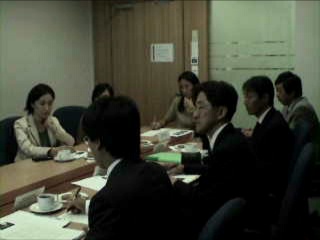 |
پ@ | |
| پi‚QپjNational Education and Research Institute پi‚m‚h‚dپj |
پœOverview It provides specialized education and training for the only teacher training in the country. In the 1950s , it was a teacher training college. In 1991 , it became an insutitusion of Yangnan College of Technology. Before 1991 , it only gave degrees , but now it also trains faculty. پœCourse to become a teacher ‡@Interviewed by the Ministry of education ‡AIf they pass the exam , they will get an apprentice position in the Ministry of Education ‡BThey are assigned to four programs based on their ‚f‚b‚dپ|‚` level performance. ‡CSalaries and tuition fees are paid by the Ministry of Education during the training period. ‡DTraining is evaluated by submitting reports. ‡EDuring the training period , students receive two weeks of teaching practice. ‡FActual classes are held at the school site , and the qualifications and aptitude as teachers are examined. ‡GAfter graduating from NIE , students must become teachers and work for three years under the jurisdiction of the Ministry of Education. ‡HIf you decide to quit teaching within three years after graduation , part of the fees paid up to that will be returned to the government. پœThree courses of teacher certification ‡@Courses for A-level exam passers or polytechnic graduates پEThe schooling period is two years for both general teachers and physical education teachers. ‡ACourses for unuversity graduates پEThe schooling period is one year for general teacher and two years for physical education teachers. ‡BCourses that allow not only teacher certification but also bachelor's degrees in humanities and science پEThe schooling period is four years. پœFive purposes of teacher training ‡@Upgrading the knowledge of teachers پEThe contents of the text book will change , so it will correspond to it. ‡ATeaching method upgrade پEImproving the way children are taught. ‡BAcquisition of necessary skills for teachers so that they can respond even if there is a generation gap. پEAcquiring skills that can respond to the younger generation , such as counseling , as society changes rapidly. ‡CIncorporating and disseminating new knoeledge from overseas پEWe will teach about changes in mathematics , science , and IT education overseas. پEWe will invite lectures from overseas and hold lectures to convey cutting-edge knowledge. ‡DAcquisition of skills to give students the ability to solve problems. Acquisition of school management skills as a manager. پETeachers will report to NIE the result of their research on how students have improved thier skills in mathematics and science. پEIn addition , teachers will make use of them in lectures and provide extracurricular instruction. پœTraining strategy ‡@Senior master program پEA course that can customize short-term training in various fields according to the teachers' request <about 12 hours> پEA course that allow teachers who don't have a degree to obtain a degree. Or a course that gives a master's degree to a faculty member who has a degree. ‡ALeadership program پEA course to become a manager پEA course to acquire senior teacher and master teacher qualifications. ‡BSpecialist program پEA course to become an expert in educational phychology or a curriculum expert and enter the Ministry of Education. پEFew people actually use this perogram. پiHuman networkپj پEMr. Aaron chong پiAssistant Headپj پںSurvey research at the National Institute of Education |
پœ"Thorough meritocracy" is also consistent with regard to measures
for teachers. Probrem such as dealing with the stress of educators due
to compettion are emerging. We would like to pay attention to future measures. پœFor those who aspire to become teachers , receiving training while receiving a salary has a clear purpose , so they are positive about training. It is useful to note that the direction of "human resourse" development by "ability development" is consistent with all measures. پœIt is useful to know that training institutes are providing qualifications that lead to the improvement of teachers' skills. |
 |
||
| پi‚RپjSengkang Secondary School |
پœOverview In general , secondary education consists of three courses. ‡@Special course پETop 10% of elementary school graduation exam scores. پEThey can learn not only advanced mother tongue but also third language. ‡AExpress course پEMiddle 50% of elementary school graduation exam scores. ‡BNomal course پEBottom 40% of elementary school graduation exam scores. پEA more practical curriculum compared to other courses. پEDivided into academic and technical courses. Sengkang Secondary School is a school with a scale of 1000 students and has Express and Normal courses. پœClassroom , class پEEach classroom has a whiteboard , a computer for the teacher , a scrren , speakers , and a projector on the ceiling to facilitate the use of computer in class. پEThere is a MathRoom (a room dedicated to math classes). Students were divided into 5 desks of 5 people each and worked on the problem of a set of 2 prints that were distributed. Each group was given only one set of prints , and everyone was working toward them under the command of the group leader. پEIn the lecture-style mathematics class in the staircase classroom , the teacher used a real projector and explained while writing on handouts and notebooks . The students were taking classes while watching the images on the projector. پœFeatures پEIt is a new school , and in response to the intention of the Ministry of Education , it is focusing on task learning. پEThere are devising forms such as learning in small groups , learning in large members all at once , and learning in indivisual subjects. پEstudents value courtesy and always greet visitors. پiHuman networkپj پEMr. Mdm Ng Shok Yan پiPrincipalپj پںIn the library , so many students were silently working on thrir own studies in prepareation for the test that there were no empty seats . |
پœIt hopes to exchange teaching methods with Japanese schools. It is important
to think about teaching methods from an international perspective. |
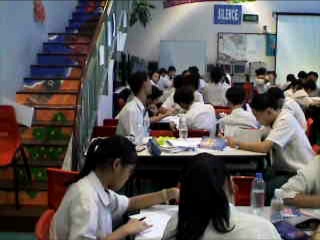 |
||
| پi‚SپjRound-table discussion with an incumbent junior high school teacher |
پœPerson 1 incumbent math teacher for express and normal courses. پœClass using IT پEHow to use computers in math class. ‡@Students make presentations using PowerPoint on simple topics. ‡AStudents obseve the graph at their own pace using graphing software. ‡BStudents searcth the Internet to solve a given problem. پESome fields of mathematics use computers a lot , while others do not. Teachers use the computers for entire hour when having students discover something , and use the computers for the first 15 minutes or so when demonstrating and explaining. The former is held in the computer room and the latter in the regular classroom. پEThere is a goal in the IT Basic Plan of "equipping one computer for two students" , but in reality it has not reached the level. پœFacility evaluation پEEach director has a different point of view , such as "Is the class effective ?" or "Are you teaching properly". Teachers with good evaluations receive awards as excellent teachers at the end of the school year. Or they can go any school they want. The principle informs the Ministry of Education , and the Ministry of Education makes changes. The names of outstanding faculty members are posted on the website. پœStudent evaluation پEIt is an absolute evaluation based on test results. Evalution criteria are determined by teachers. پEFinal exams are held twice in March and October. پETests are done term by term. پEThe evaluation weight is 10% for each term test and 40% for the final test. پiHuman networkپj پEMr. Zhuo Lai Xing (Junior high school teacher) پںScene from the round-table discussion |
پœIf teachers can not use computers , they partitipate in training so that
all teachers can use them. In Japan , as well , it is necessary for all
teachers to be able to use computers and actively participate in training
so that they can teach using computers. |
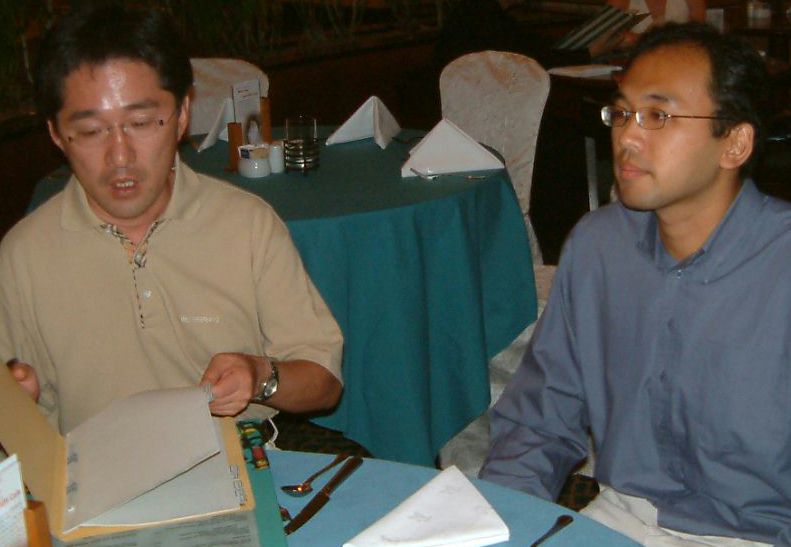
|
||
| پi‚TپjSingapore ¥ Polytechnic |
پœOverwiew The school opened in 1954. The educational goal of Polytechnic is to give students who are interested in industrial technology and commerce a practical education centered on hands-on experience in laboratories and workships. This is to develop mid-level human resources that meet the needs of Singapore's industry and commerce. There are disciplines such as engineering , commerce , mass media , marketing , graphics , manufacturing design , interior design , computers , nursing and radiography , and students study their area of specialization for three years. پœFeatures پEThey have a close relationship with companies and are jointly developing canned drinks. پEthey introduce an internship system. پEIt is well-equipped with audio-visual equipment and proffesional staff to support the development of students' presentation skills. پEStudents have a clear goal of acquiring skills , so they are highly motivated and less likely to drop out. پiHuman networkپj پEMr. Takamitsu Hirata Full-time Lecture , Japanese Department , Faculty of Foreign Studies پںInvestigative research at Singapore Polytechnic |
پœit is useful to note that polytechnic focuses on things that are immediately
useful after entering society , such as cooperation with companies and
an intership system. |
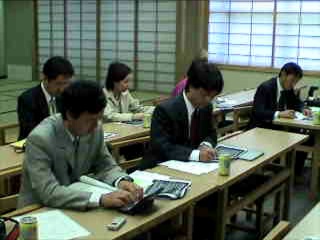
|
||
| پi‚UپjCouncil of Local Authorities for International Relations (CLAIR) |
پœA word from CLAIR Like Japan , Singapore lacks natural resources , and its greatest resource is human resources. However , as the country is smaller than Japan , it can not be said that there is room for human resource development. Until now , the focus has been on how to efficiently develope excellent human resources in practical terms. Reflecting on this , Singapore is trying to transform itself into a relaxed and mature nation against the backdrop of diversifying values among its citizens. پœFuture issues ftom CLAIR's point of view ‡@Strict education system for children In Singapore , there have been reports of children feeling stress about their academic performance and future career paths due to the severe competition in entrance exams from the lower grades of elementary school. Concerns have been raised about the impact of a harsh education system on children. ‡ADraining brain Singaporeans have high accademic ability and English proficiency compared to the rest of the world. therefore , it is relactively easy to advance to overseas universities , research institues , and companies. Ministries , statutory institutions , and private companies are striving to recruit excellent students by offering rarious scholarships to prevent the outflow of excellent human resources who are willing to go abroad. However , after graduating , many students remain at their study abroad destinations or refuse to find employment at the institutions or organizations that provide scholarships , which is becoming a social problem. پiHuman networkپj پEDirector of cancil for Local Authorities for International Relations Mr. Fumiaki Ikushima پEDeputy Director of Local Authorities for International Relations Mr. Takaaki Ogata پECouncil of Local Authorities for International Relations Ms. Reiko Kobayashi پںSurvey research at the council of Local Authorities for International Relations |
پœSurvey and research on education in Singapore were also conducted , and
materials were provided. We believe that we will continue to receive cooperations , such as the provision of materials , etc. |
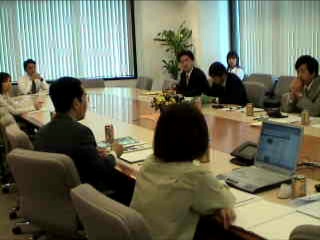
|
||